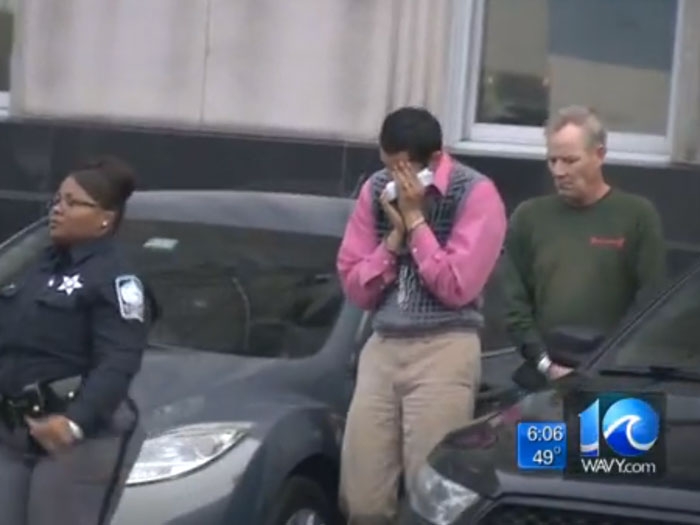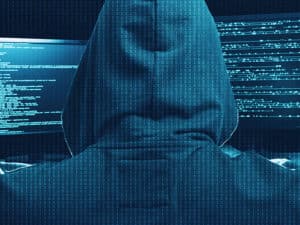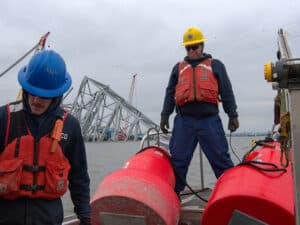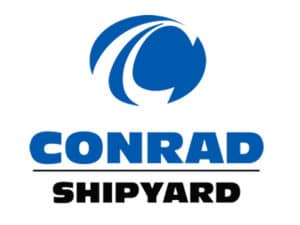
Feds: Navy civilian engineer tried to sell CVN 78 secrets
Written by Nick Blenkey
Virginia broadcaster WAVY, which broke the story, aired footage of Awwad outside Federal court
DECEMBER 7, 2014 — Mostafa Ahmed Awwad, 35, a Saudi-born civilian engineer working for the Navy, was arrested Friday on charges of trying to give classified information on the aircraft carrier Gerald R. Ford (CVN 78) to the Egyptian Government.
Under construction at Newport News Shipbuilding, the Gerald R. Ford is the lead ship in a new class of nuclear-powered aircraft carriers and incorporates many breakthrough technologies.
According to court documents, Awwad was born in Saudi Arabia, married a U.S. citizen in Cairo in 2007, and took steps to become a U.S citizen. He was hired to work at the Norfolk Naval Shipyard’s nuclear engineering and planning department in February and received security clearance in August.
He was indicted earlier this week on two counts of attempted exportation of defense articles and technical data. Each count carries a possible 20-year sentence. On Friday, December 5, he was led into U.S. District Court in Norfolk, VA, and will be held in jail pending a bond hearing.
The charges result from an FBI and NCIS undercover operation.
According to court documents, the Egyptian intelligence officials Awwad believed he was working for were in fact undercover federal agents.
Details of the operation are given in an FBI affidavit, obtained by Virginia broadcaster WAVY. The affidavit reads like the plot for an old fashioned espionage novel, complete with dead drops, a handgun, secret documents and undercover agents.
The “false flag” operation that caught Awwad began September 18, the affidavit said. An FBI agent telephoned Awwad, identified himself in Arabic as “Yousef” from Washington, DC, and asked for a meeting at a public park in Hampton.
Without asking for additional information, Awwad agreed, the affidavit said.
At the meeting in the park, says the affidavit :
“Awwad claimed it was his intention to utilize his position of trust with the U.S. Navy to obtain military technology for use by the Egyptian government. Awwad discussed various aspects of U.S. radar technology, U.S, nuclear aircraft carriers, ballistic nuclear submarines, and nuclear attack submarines with Yousef in an effort to describe his ability to obtain information for the Egyptian government. Awwad advised Yousef he intended to copy the designs to the USS Gerald Ford aircraft carrier onto CDs for the Egyptian government. Awwad agreed to conduct clandestine communications with Yousef by email and unattributable telephones and to conduct Dead Drops in a concealed location of the park. Before departing, Yousef showed Awwad a concealed Dead Drop site in the park for future use which Awwad agreed to use. Yousef then provided Awwad with an email address and instructions for clandestine communication. Awwad was instructed to send Yousef an email with the subject line “Sick” if an emergency arose. At the conclusion of the meeting, Awwad revealed a.45 caliber handgun he had brought with him to the meeting.”
The first drop was supposed to happen Oct. 2, but Awwad did not follow through. However, a second meeting was arranged for Oct. 9, with Awwad asking that Yousef bring him a laptop computer, thumb drives, an external hard drive, and a pre-paid phone.
At the hotel meeting, says the affidavit:
Awwad suggested an elaborate cyber safety system which included several one-time use electronic mail boxes with phantom names to set up secured communications with Yousef. Awwad described a detailed plan to circumvent US Navy computer security by installing a ‘bug’ on his restricted computer system [to] enable him to copy documents without causing a security alert. Awwad provided Yousef with four (4) computer aided design (CAD) drawings of a US nuclear aircraft carrier which he claimed are Top Secret. Awwad discussed where to strike the vessel with a missile in order to sink it. Awwad acknowledged that it is unlawful to export the CAD drawings of the aircraft carrier he had provided to Yousef. In the discussion, Awwad indicated his understanding that the drawings would be sent to and used in Egypt. Awwad also discussed a CNC milling machine he is building with the potential to replicate US military technology and equipment for Egypt. Awwad indicated an intent to ship the C IC milling machine to Egypt. Awwad indicated he was going to secretly rent a small storage unit where he could store stolen information. Awwad asked Youseffor $1,500 to purchase a pin hole camera which he would wear around the shipyard to photograph restricted material. Awwad admitted he had been illegally downloading information from his restricted U.S. Navy computer system for several months prior to meeting Yousef. Awwad also admitted he had taken the downloaded information to his home. …
At the conclusion of the meeting, Awwad agreed to provide Yousef with passport photos which would be used to produce a fraudulent Egyptian passport so that Awwad could travel to Egypt without alerting US government officials. Before adjourning the meeting, Awwad activated two (2) pay-as-you-go Tracfones for clandestine communications with Yousef.
The two men later arranged for Awwad to make a drop on Oct. 23 in Hampton.
The affidavit said Awwad removed $3,000 in cash from a camouflaged hole and put in its place a 1-terabyte external hard drive and two passport photos he thought the Egyptians would use to make a fraudulent passport. Agents found six more drawings of the Ford on the hard drive.
The affidavit says:
On October 10, 2014 the FBI reviewed the CAD drawings provided by Awwad which were of a United States aircraft carrier, the USS Gerald R. Ford, CV 178 . Many of these drawings contained the following text:
WARNING: THIS DOCUMENT CONTAINS TECHNICAL DATA WHOSE EXPORT IS RESTRICTED BY THE ARMS EXPORT CONTROL ACT (TlTLE 22 U.S.C. SEC 2751 ET. SEQ.) OR THE EXPORT ADMINISTRATIVE ACT OF 1979, AS AMENDED, TlTLE 50 U.S.C. APP. 2401 ET. SEQ. VIOLATIONS OF THESE LAWS ARE SUBJECT TO SEVERE CRIMINAL PENALTIES.
The drawings also were marked ‘NOFORN,’ which is a restriction on the distribution of defense materials that prohibits their release to non-U.S . Citizens.
The investigation continued and, according to the affidavit:
On Friday, November 28, 2014, Awwad was observed entering his office at Norfolk Naval Shipyard holding a cardboard tube about 3′ long. Once in the office, Awwad opened the cardboard tube and took out several white sheets which appeared to be design schematics. Awwad then placed the schematics on the floor of his office and photographed them with what appeared to be a pocket camera. Awwad took multiple photos of each schematic which were approximately 10 feet long. The schematics appeared to be various profiles of an aircraft carrier. After approximately 45 minutes of viewing the schematics and taking photographs, Awwad placed all the schematics back in the cardboard tube. Subsequently, Awwad walked down the hallway towards other spaces on the same floor. Awwad was out of view for approximately 2 minutes. Upon returning to view, Awwad did not have the cardboard tube. Awwad then packed up his items, closed his office space,and departed the office.
You can download the redacted affidavit from WAVY’s website HERE





Leave a Reply
You must be logged in to post a comment.